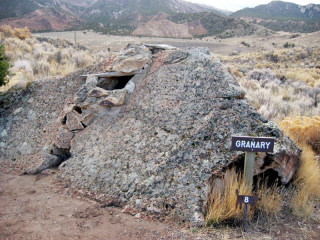Explorer Corps Marker: Sevier County
Find the Marker
The Sevier County marker is just to the left of the fee box and entrance sign to Fremont Indian State Park and Museum, which offers wonderful views of Clear Creek Canyon. The State Park is located at 3820 Clear Creek Canyon Road in Sevier.
GPS 38°34’39”N 112°20’8.52”W
Dig Deeper
Sometimes archaeology turns into a rescue mission. In 1989, the construction of I-70 through the San Rafael Desert of Sevier County threatened to destroy and cover over archaeological sites that had been inhabited by Native American people in Clear Creek Canyon. Archaeologists coordinated with the Paiute Indian Tribe of Utah and rushed to excavate the area that was at risk, uncovering evidence of how important Clear Creek Canyon has been to Native American peoples through generations.
Water is an essential resource in the desert, and the perennial stream that gives Clear Creek Canyon its name made this a special place through the millennia. The oldest archaeological evidence for habitation at Clear Creek Canyon dates back to about 4,000 years ago, what archaeologists term the Archaic cultures, but that’s hardly all. About 800 years ago, people of the Fremont culture lived here, followed by Ute and Southern Paiute peoples around 300 years ago. Time and again, Clear Creek Canyon was an important spot for hunting and farming.

Archaeologists have uncovered and analyzed a great deal as they’ve been trying to piece together the history of Clear Creek Canyon, from taking radiocarbon dates and tree ring chronologies to the excavation of Five Finger Ridge – one of the largest Fremont villages known. Archaeologists have documented pithouses, granaries walled with adobe, storage rooms, and more, many of which date back to the Fremont culture.
But Clear Creek Canyon was not an isolated spot on the map. The villages and habitations in Clear Creek Canyon were connected to others in the southwest, and small items found during the excavations have helped archaeologists detect trade routes between different places. Turquoise ornaments, colored stone, shell beads, clay figurines, ceramics, and even the way structures were built help highlight the trade and social networks between groups of people.
Ceramic pieces found in Clear Creek Canyon have been some of the most important for teasing out these clues. The ceramics found in the Clear Creek Canyon sites look like those found in Parawan Valley further to the south. There was some form of trade between these places, part of even larger networks as artworks and goods made their way to different communities of people.
The history of the canyon and the people who lived there involves more than the rock art, buildings, and artifacts, though. Utah’s changing climate likely had a major influence on where people lived and at what times. By looking at pollen records and figuring out what plants grew in the area, for example, archaeologists have been able to determine that the local climate in Clear Creek Canyon during the Archaic period was relatively dry. Within a few hundred years, however, the climate grew warmer and wetter until about 4,000 years ago, when things cooled down again. Archaeologists are still studying records like these, a history not just of this remarkable place but of connections through time.
Want to Go Farther?
Fremont Indian State Park and Museum offers trails and other opportunities for recreation in the area.